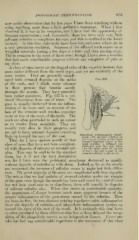Page 965 - My FlipBook
P. 965
PHAGEDENIC PERICEMENTITIS. 975
now under observation that for five years I have been watching without
using anything more than a little palliative treatment. When I first
ob.served it, it was in its inception, and I have had the opportunity of
frequent examination ; and, fortunately, there has been only very little
salivary calculus to complicate the case, and this is confined to the lower
incisors. In this time eight teeth have been lost, and some others are in
a very precarious condition. Soreness of the affected teeth comes on at
irregular intervals, lasting a few days at a time and then passing away.
This is common to the most of these cases, though I have seen a number
that had made considerable progress without any complaint of pain at
any time.
A class of cases occur on the lingual sides of the superior incisors that
seem rather different from the usual types, and yet are evidently of the
same nature. They are generally compli-
cated with serumal deposits on the necks Fig. 526.
of the teeth, and I think occur oftenest
in those persons that breathe mostly
through the mouth. They have generally
been rather persistent. Fig. 527 is a sec-
tional illustration from one of these. The
gum is usually thickened from the inflam-
mation of its tissue and on account of the
lo.ss of the alveolar wall recedes, exposing
more or less of the roots of the teeth. The
teeth are often protruded to such an extent
as to render them unsightly. They are
usually very slow in their progress, and
are apt to have serumal deposits extending
Phagedenic Pericementitis compli-
high up toward the apex of the root. cated witli Serumal Calculus on
the Lingual Surface of the Upper
Thus far I have spoken mostly of that
Incisors (sectional view): cr, ser-
class of cases that have not been complicat- umal calculus; b. inflamed and
thickened gum that has fiillen
ed with deposits of salivary or serumal cal- into the space made by the loss
of bone, exposing a part of the
ulus. This may. be said to be the simplest serumal calculus; c, pus-cavity.
form, but it is not the least destructive
one, for I have seen the peridental membrane destroyed as rapidly
without deposits of calculus as with them. Indeed, so far as the results
are concerned, the presence of calculus seems to make but little differ-
ence. The great majority of the cases are complicated with these deposits.
The rule is that we find nodules of serumal calculus under the margin
of the gum even though the mouth has been well cared for ; and if there
has not been good care as to cleanliness, there will usually be deposits
of salivary calculus also. When this occurs in considerable quantity,
the appearance of disea.se becomes much more apparent because of the
greater inflammation of the gum-tissue cau.sed by the calculus. Here
we have, in fact, the two diseases existing together—calcic inflammation
from the deposits of calculus, and phagedenic inflammation farther up
toward the apex of the root of the tooth. It is evidently this dual form
so often presented by these affections that has so long delayed the recog-
nition of the phagedenic variety as an independeiTt disease. Every one
who has had any considerable experience in the treatment of this class


